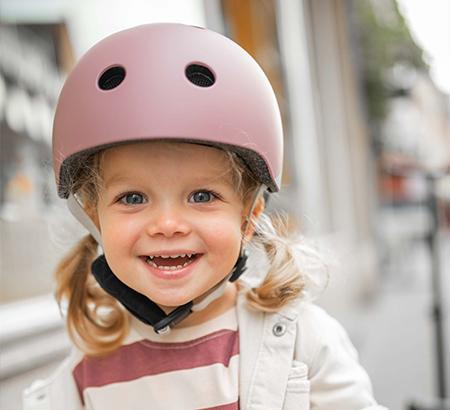A helmet is an indispensable companion for children, whether they are riding a scooter, bike or other vehicle. However, a helmet only provides optimum protection if it fits properly and is correctly adjusted. In this article, we explain step by step how to fit your child's helmet correctly and what you should look out for when choosing the right size.
1. Find the right size
The first step is to choose the right helmet size. Helmets from Scoot and Ride are available in two different sizes (XXS and S), depending on the circumference of your head. How to measure correctly:
- Use a tape measure: Take a flexible tape measure and measure the circumference of your child's head about 1 to 2 cm above the eyebrows and ears.
- Note the size information: Compare the result with the size indicated on the product. If your child is just between two sizes, choose the larger size - then your child will enjoy the helmet for longer.
A helmet that is too small pinches and is uncomfortable, while one that is too big wobbles and does not offer sufficient protection. The size can be individually adjusted using the adjustment wheel on the back of the helmet. This means the helmet always fits just right.
2. Check the optimum fit
A well-fitting helmet should meet the following criteria:
- Horizontal position: The helmet sits straight on the head and covers the forehead. The distance to the eyebrows should be about two fingers wide.
- No wobbling: The helmet stays on your head even without the strap fastened.
- Comfort: The helmet must not pinch or be uncomfortable.

3. Adjust the belts correctly
The helmet straps play a crucial role in safety. Here's how to adjust them correctly:
- Adjust the Y-strap: The side straps should come together in a Y-shape just below the ears. Also make sure that the straps are not twisted.
- Fasten the chin strap: The chin strap should be adjusted so that a maximum of one finger fits between the strap and the chin. The strap should not cut in, but also not be too loose.
4. Additional tips for the ideal fit
- Take hair into account: If your child often wears a plait, this should be taken into consideration when setting it.
- Check regularly: Children grow quickly, so it is important to check the fit of the helmet at regular intervals.
5. The importance of quality and certification
When buying, look for helmets with valid safety certificates, such as EN 1078. This standard ensures that the helmet has passed strict tests and offers a high level of protection. Quality helmets are often made of robust material and offer additional padding for comfort.
A well-adjusted helmet is the key to your child's safety when riding a scooter. Take the time to determine the correct size and adjust the fit to the optimum. With a helmet that fits properly, adventures on two wheels are even more fun - and you can rest assured that your child is protected.